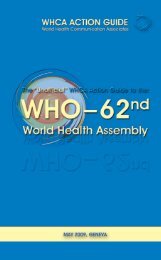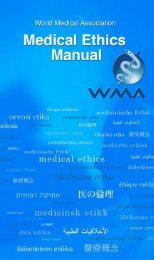the basics - World Health Communication Associates
the basics - World Health Communication Associates
the basics - World Health Communication Associates
- No tags were found...
Create successful ePaper yourself
Turn your PDF publications into a flip-book with our unique Google optimized e-Paper software.
chronic disease patients has been identified (Youmans & Schillinger 2003). Trainingworks best when it is informed by users with limited health literacy, who are oftenunder-represented in clinical research (IOM 2004).BOX 6 : CASE VIGNETTECHRONIC DISEASE MANAGEMENT PROGRAMME (IOM 2004)Researchers and practitioners at <strong>the</strong> University of North Carolina in USA havedeveloped several chronic disease management programmes that are designedto identify and overcome literacy-related barriers to care. The programmes, whichinclude interventions for diabetes, heart failure, chronic pain and anticoagulation,are led by clinical pharmacist practitioners and trained health educators, whouse evidence-based algorithms, a computerised patient registry and literacyindependentteaching techniques to facilitate effective self-care and assure receipt ofeffective services and medications. The teaching techniques are used in a one-on-oneinteraction with <strong>the</strong> patient during clinic visits and feature:• A teach-back method in which <strong>the</strong> patient teaches <strong>the</strong> content back to <strong>the</strong>educator• Practical skills ra<strong>the</strong>r than complex physiology• Written educational materials designed for low-literacy users that <strong>the</strong> educatorreviews with <strong>the</strong> patient• Follow-up telephone calls and quick visits by <strong>the</strong> educator when <strong>the</strong> patientreturns to <strong>the</strong> clinic, that serve to reinforce <strong>the</strong> education• A collaborative learning environment based on sensitivity to <strong>the</strong> role of literacyin communication with patientsIn each area, <strong>the</strong> programme organisers have systematically measured literacyas well as relevant health outcomes. For diabetes and anticoagulation, completedstudies have found that <strong>the</strong>se programmes can offset <strong>the</strong> adverse effects of lowliteracy.A typical training programme might introduce providers to <strong>the</strong> conceptof limited health literacy in patient populations, pointing out <strong>the</strong> implicationsfor <strong>the</strong> delivery of health care services. It might provide techniques to improvecommunication with patients who have limited health literacy skills. ProgrammesSECTION 4: WHAT CAN WE DO TO STRENGTHEN HEALTH LITERACY? 39






